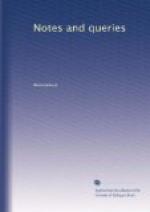H.H.
The Letter Yogh (Vol. ii., p. 492.).—Yerl for Earl, and yirth for earth, &c., are, to this day, quite common in Scottish orthoepy among many of the lower classes.
G.F.G.
Did Elizabeth visit Bacon at Twickenham Park? (Vol. ii., pp. 408. 468.).—To this question your correspondent J.I.D. replies with a quotation from Nicols (edition of 1823), who dates her visit in 1592 or 1593. I had looked into Nichols’s first edition (1788) without finding the subject mentioned; and I am now inclined to think, as at first, that it is altogether a misapprehension. Sir Francis Bacon, in His Apologie in Certaine Imputations concerning the late Earl of Essex, written to the Right Hon. his very Good Lord the Earle of Devonshire, Lord-lieutenant of Ireland. Lond. 1604, in 16mo. pp. 74., says, at p. 32.:—
“A little before that time, being about the middle of Michaelmas terme, her Maiestie had a purpose to dine at my Lodge at Twickna[m] Parke, at which time I had (though I professe not to be a poet) prepared a Sonnet, directly tending and alluding to draw on her Maiesties reconciliation to my Lord,” &c. &c.
This I conceive to have reference to an intention of Elizabeth, rather than to an accomplished fact.
At p. 14. of this work, Bacon says he had sold Twickenham park some time ago to Reynold Nicholas. I consider Lysons to have been the first author who mentions the subject and at Environs, vol. iii. (1795), p. 565., there is a note: “From the information of the Earl of Orford.” And I therefore conclude it to have been some mistake of Lord Orford’s.
YOUR FORMER CORRESPONDENT.
Dec. 27. 1850.
Mock-Beggar (Vol. ii., p. 478.).—The origin of this term was discussed in the Gentleman’s Magazine in 1840. Two localities so called were cited (vol. xiv. p. 114.), with the opinion of Sir William Burrell, that some buildings so named at Brighton had been “a mendicant priory.” Another writer (p. 331.) suggested that the term was applied to country houses when deserted or unoccupied; or to rocks, as one near Bakewell, where the semblance of a ham might attract a wayfarer from the high road, only to deceive his expectations of relief.
J.G.N.
Cardinal Chalmers (Vol. ii., p. 493.).—The insignia mentioned by your correspondent S.P., in No. 60, are very common among Roman Catholic ecclesiastics on the Continent, and are frequently to be seen on tombs. The hat and tassels are appropriated to Notaries Apostolic of the Holy Roman See, as well as to Cardinals and the dignity having some privileges attached to it, it is sought after by ecclesiastics of standing.
HYDE CLARKE.
Binsey, God help me! (Vol. i., p. 247.).—I remember the same words respecting the village of Binsey, half-way between Oxford and Godstow. During the winter and spring months it was nearly all under water, like Port Meadow, on the opposite side of the river: so if you asked a Binseyite in winter where he came from, the answer was as above; if in summer, “Binsey, where else?”




